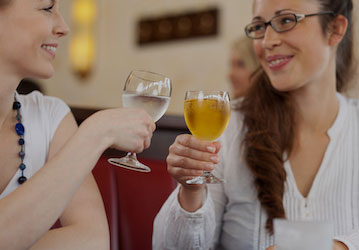Have you recently cut down on or quit drinking, or are you thinking about it? If so, you might be wondering how you can be social and spend time with your buddies while sticking to your goal of saying “no” to alcohol.
For many Warfighters, downtime with your unit, teammates, family, and friends plays an important role in maintaining your day-to-day well-being and is even more important in times of stress. Whether you’re at a sporting event or family barbecue, celebrating your buddy’s promotion at the bar or your significant other’s birthday, or just hanging out after your shift ends, social situations often include drinking. And in those situations, you might notice either direct or indirect pressure to drink alcohol.
Social pressure
An example of direct social pressure might be your buddy asking, “I’m buying this round, you want a beer?” On the flip side, indirect social pressure might be a little subtler. For example, imagine you’re hanging with friends at a bar, eating wings, and watching the football game. You see others order drinks, and even though no one asks or tells you to drink, you recall being in a similar situation and drinking. That memory and the feelings it brings might push you to order a drink too.
Strategies for success
Early on in your attempts to cut down on drinking, if a situation seems particularly risky, sometimes the best option is to avoid it altogether. However, avoiding all social situations isn’t always possible or desirable. Fortunately, there are ways to say “yes” to staying social and sober.
Recognize your risks. Before you go into a social situation, evaluate what you might run into that could lead to drinking alcohol or even drinking too much. Think about the location, who will be there, the time of day, your stress level, and any prior experiences in similar circumstances. Remember things you did that helped you avoid drinking in past situations and any stumbling blocks that made it more difficult. Thinking about what to expect can help you plan how to respond if you feel an urge to drink or if someone offers you alcohol.
Create a plan to say “no” and rehearse it. Start with some “If...then” statements and rehearse saying “no” in a way that helps you feel comfortable. Short, clear, direct responses with little explanation can help avoid any extra discussion. Simple responses such as “No, thank you,” “No, I don’t want to drink,” or “No, water is good for me” are some great options. Practice saying these out loud while imagining yourself in the situation.
Be prepared to repeat your response. Sometimes people might ask again or insist. When the level of peer pressure increases, be prepared to say “no” again. Answering without hesitation and using direct eye contact when you say “no” also can help you feel and appear more assertive.
Use reinforcements. You might not want to open up to everyone about your decision to drink less, and that’s okay. But telling a close friend or partner can help when you’re trying to cut down on your drinking. He or she can serve as a reinforcement in risky settings too. Depending on your level of comfort, you could ask, “Hey man, I’m trying not to drink tonight. Can you watch out for me and run interference if anyone gets pushy?” Or ask your friend to leave an event with you if it’s getting harder to resist the urge to drink. If you’re comfortable, you also can ask your buddy to role-play how you’ll say no to alcohol.
Replace risky social activities with alcohol-free fun when possible. For example, suggest going to see a movie with friends instead of heading to a bar. And if you can’t replace the event, then replace the drink itself. For instance, when your buddy offers to buy you a drink, order water, tea, or soda instead. If you’re cutting down, but not necessarily quitting, alternate alcoholic drinks with water to help space out your drinking.
Remember it’s OK to leave. Despite the best preparation and planning, there are times when it will be hard to say “no.” When this happens, leaving the situation becomes a critical skill. Giving yourself permission to exit will allow you to prepare and attack your goal that much better next time.
Interested in learning more? Check out “6 tips for your wellness mission” to find out how to say “yes” to being social while saying “no” to alcohol.
